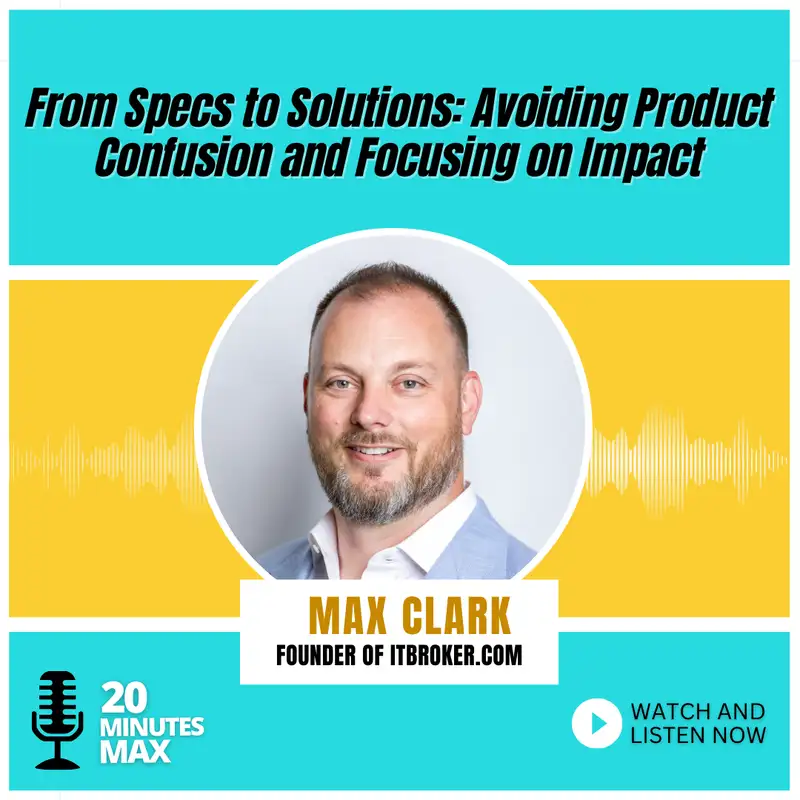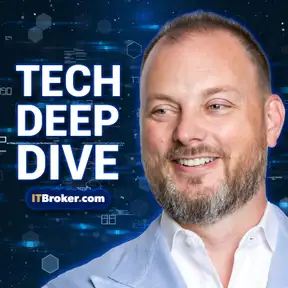From Specs to Solutions: Avoiding Product Confusion and Focusing on Impact
Hi. I'm Max Clark. This is the problem with tech sales. This is not a new problem. I've been in tech.
Speaker 1:I've been an IT practitioner for over 25 years. It was a problem when I started. It's still a problem today. It's probably problem in the fifties. Probably gonna be a problem in 2050.
Speaker 1:There's a bunch of problems. But the the main problem is ultimately tech gets positioned and sold based on features speeds and feeds you know this this box has a 2.9 gigahertz thing this thing has 27 megabytes of storage thing this has a network interface thingy now if your job is to evaluate the difference between technical thingies, you care about those specs. You care about that stuff. Right? You know, if you wanna take pictures of your children, you know, are you looking at the difference between, you know, a 21 megapixel and a 33 megapixel camera?
Speaker 1:Like, what are the difference between those for you? How do you figure that out? Oh, the 33 is bigger, so I must want it. Except that 33 megapixel might have a rolling shutter issue. It might have an issue with capture rates.
Speaker 1:It could have when I say issue, like, maybe maybe the 21, you know, 21 megapixel has a deeper frame buffer. It can take more photos because it has, you know, like like this becomes a trade offs. Bigger is not always better in tech. So that's just a little side here that we're going to now. And then this gets even more murky because as soon as somebody like Gartner defines a category, everyone that's adjacent to that category tries to shove their product or service into that category to say that we can do this thing because now they know it's gonna be an evaluation line.
Speaker 1:And you get up into these horrible things like, yeah, we do SD WAN. Yeah. We do Sassy. Yeah. We do clustering.
Speaker 1:Yeah. We do this. Yeah. We do that. And it's like, yeah, you kinda do it.
Speaker 1:Sure. Like like, technically, you're not lying. But, no, you don't really actually do this. And this becomes a big circular problem because we get so focused on, you know, the speeds and feeds that we forget the actual reason why people buy this stuff. Right?
Speaker 1:What are they actually trying to do? At the end of the day, people have to get a job done. What is the job they're trying to do? What is the problem they're trying to solve? What is the objective they're trying to get, you know, like, achieve?
Speaker 1:What is the job that they're trying to do? And can you help them with that job? And based on that need, how do you actually map technology to it? Right? So this is that whole joke to to, you know, to somebody with a hammer, everything looks like a nail.
Speaker 1:Same thing with IT and tech. Everything has a technical solution to it. You know, the question is whether or not that actually should be the case or not. Right? Like, does tech actually solve the problem or make the problem worse?
Speaker 1:You know, like, do we need to address this issue differently? And I feel like we need to create some sort of, like, Hippocratic Oath for IT people being like, you know, I'll do no harm. Like, I will not create complications and and unnecessary layers of of systems and infrastructure for the business unless it's actually required and necessary based on what we're actually trying to achieve and do. Because, by the way, you implement a system, then you need to make the system redundant, then you have to back the system up, and the system has to talk to another system and all. And you end up with this, like, spiraling weave of rat's nest of of stuff.
Speaker 1:So, anyways, back to the point here. Point of this is is that if you're an IT or tech person and you're talking about the speeds and feeds, figure out how to talk about value and jobs to be done. If you're in tech marketing, again, what does the person on the other side what are they able to do that they weren't able to do before? What are they trying to do? What what do they get?
Speaker 1:Not not to get 21 megapixel or 33 megapixel or 1.21 gigawatt. You know, like, they don't they don't care about that. Right? And again, like, the best example of this was Apple's campaign, 10,000 songs in your pocket. Right?
Speaker 1:Like, nobody cared that the device had they didn't even publish how much storage was in these devices. Apple didn't publish how much storage was in these devices for years. Like, they 10,000 songs in your pocket. Like, that's what you could do with it. You had 10,000 songs in your pocket.
Speaker 1:Figure out what your version of 10,000 songs in your pocket, And I promise you, you'll be way more successful at positioning your product, your service identify, you know, to your customer and your customer will understand what you do a lot better. Right? 10,000 songs in your pocket, not 512 megabyte. It's actually it wouldn't have been megabyte. Well, you know, what was the original iPods like 60, you know, 64 gigabyte?
Speaker 1:No, it wasn't that big. Like they were small. Right. See, I don't even know. I don't even remember because that's not how it was positioned.
Speaker 1:You know, I could figure this out was an MP 3 back in the day, probably, you know, 128 kilobytes. So, you know, they're small, but 10,000 songs in your pocket. You remember that? I'm an IT nerd. Just think about that one for a second.
Speaker 1:Right? I'm an IT nerd, but I'm a person. And that's the difference. That's how this stuff works, and that's how you should be thinking about this. And if you can figure out that transition by the way, if you're talking speeds and feeds, just figure out how to stop.
Speaker 1:Like, just slap yourself in the face every time that you start talking about a speed and a feed. Unless you're talking to another IT nerd, You wanna call me up. We can have a nerd session. Happy to talk about it. So that way you can, like, vent and get it off your chest and you can go talk to other people and it doesn't have to be nerdy.
Speaker 1:Right? You can go talk about the value that they're getting and what they're getting out of it and what what your product or service does for them and how it helps them in their life. It's not like this other thing. I'd love to hear your example of it. What's a good example of 10,000 songs in your pocket that you've seen for a piece of tech?
Speaker 1:I'd love to see examples. I'd love to collect more of these things. I think this is going to be a massive unlock for a lot of people trying to figure out how to communicate with nontechnical people and actually help their businesses and get what they want. Like, everybody wants, like, improvement and leverage and value. Let's help them.
Speaker 1:Hope this helps.

